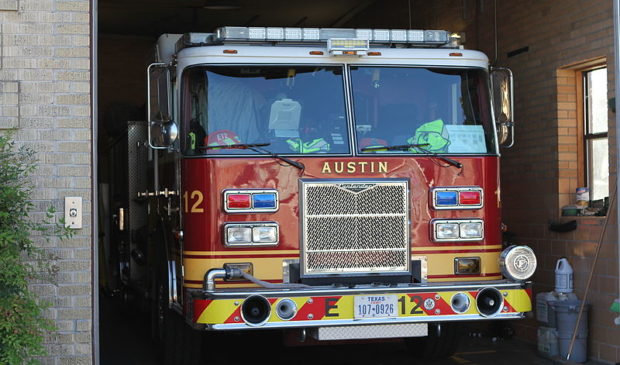Firefighters union touts increased diversity
Tuesday, October 3, 2017 by
Jack Craver Austin is far from having a fire department that reflects the diversity of the city, but it’s made significant strides since the U.S. Department of Justice sued the Austin Fire Department over its hiring practices.
Days after clashing with a City Council member over firefighter demographics, Austin Firefighters Association President Bob Nicks delivered an optimistic report to the Public Safety Commission in which he touted increases in minority hiring.
The Fire Department has nine more African-Americans, 22 more Hispanics and 70 fewer whites than it did four years ago, when a Department of Justice investigation found that its hiring practices discriminated against minority applicants, he told the commission at its Oct. 2 meeting.
Nicks attributed some of the improvements to the union’s participation in recruitment efforts.
Greg Pope, the secretary and treasurer of the union, also described various engagement efforts with the African-American community, including talking with the president of the Austin NAACP, to consider how to get more African-American applicants.
Pope is also the program manager for the Pass the Torch Academy, a series of nine weekend sessions that give young people who have an interest in becoming a firefighter or paramedic the opportunity to learn a number of skills related to the jobs. The department has touted the “mini-academy” as an effective way to get more female and non-white people to give firefighting a try.
The union, said Pope, has tried hard to “remedy the problem of diversity” in the department.
And yet, despite the improvements, the Fire Department remains far whiter than the population it serves. According to the department, 77 percent of Austin firefighters are Anglo, compared to only 47 percent of Austinites. Hispanics account for 36 percent of residents but only 16 percent of firefighters. African-Americans are about 7 percent of the population but only 4.6 percent of the department. Asian-Americans now make up 6.8 percent of the population but only 1.8 percent of firefighters.
Those figures put the department right between its two fellow public safety agencies in terms of diversity. African-Americans and Hispanics are even more severely underrepresented among emergency medical service employees, 80 percent of whom are white. The Austin Police Department is only 69 percent white, and the percentage of the force that is African-American (8.6 percent) is actually higher than in the city as a whole.
Commissioner Rebecca Gonzales, who has led a working group of the commission focused on diversity within the public safety workforce, said that she wants to look to other cities for ways to get more minority applicants for city positions. She noted that EMS has partnered with the city’s Innovation Office to put together the next EMS recruiting event in the hopes of eliciting more interest from underrepresented groups.
“We never expect to say that as a working group we’ve solved all of the issues,” she said.
Chair Rebecca Webber asked Nicks whether he believed that there were any provisions of the union contract that were responsible for the lack of diversity in the department, a suggestion Nicks firmly rejected.
“That’s just not true,” he said, pointing out that the department had become more diverse in the years since the union began participating in recruitment efforts. “I’m showing the results of our involvement.”
However, despite vehemently opposing the 2014 consent decree between the city of Austin and the Department of Justice over firefighter hiring, Nicks declined to blame the agreement for the department’s lack of diversity. He did, however, blame the decree for staff shortages and high overtime costs.
Photo by J.Köster made available by a Creative Commons license.
The Austin Monitor’s work is made possible by donations from the community. Though our reporting covers donors from time to time, we are careful to keep business and editorial efforts separate while maintaining transparency. A complete list of donors is available here, and our code of ethics is explained here.
You're a community leader
And we’re honored you look to us for serious, in-depth news. You know a strong community needs local and dedicated watchdog reporting. We’re here for you and that won’t change. Now will you take the powerful next step and support our nonprofit news organization?



